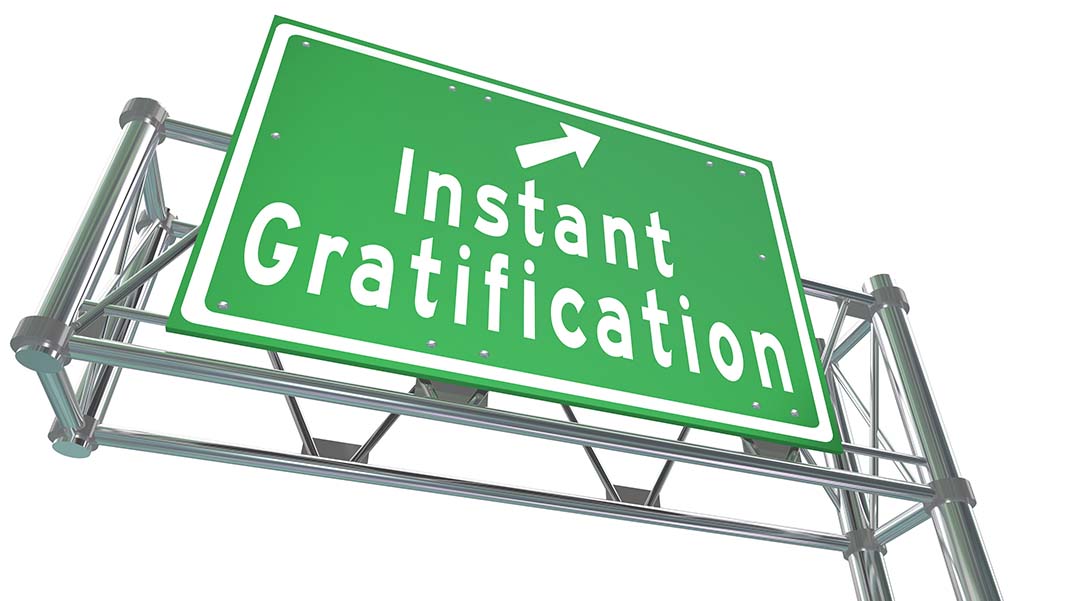The Importance of Instant Gratification in Customer Service
By: Megan Totka

We live in a world where we expect almost instant gratification in most things.
Whether it’s social media feedback, sandwich delivery, or an Amazon Prime order, faster is better, and instant is best.
Much of this stems from our constant availability and connection through technology. A boss can reach an employee at almost any time. A customer can reach a company about an order, an issue, or their experience almost instantly, and they expect to receive a response almost as fast.
For companies with a Facebook business page, response times are even measured and posted, so customers and clients know if you typically response within an hour, a day, or more. Customers know right away if you’re responsive, and how quickly they can expect you to give them the answers and feedback they need.
All of this instant gratification has set the bar pretty high when it comes to customer service. Customers will no longer tolerate slow lag times, or a website that isn’t responsive, mobile friendly and almost intuitive to their needs. In fact, if you aren’t responding to your customers concerns and feedback right away, chances are high that your customers will take their business elsewhere.
How Customer Service is Adapting
Social media and customer interaction has increased and become top priority. Back before the tech shift (and even up to a few years ago), a customer might be satisfied with a simple response, a canned comment or a return phone call.
Now, customers love the responsiveness of instant “live chats” with service reps, or the ability to get a representative on the phone and fixing their problem instantly. It’s even better if a customer doesn’t have to submit a ticket and wait for a customer service representative to respond.
This means companies have to build in a larger budget for customer service. They need to offer accommodations, mobile-friendliness and instant availability, as well as reduce their response times.
In order to accommodate this new, fast and friendly style of customer service, many companies are opting for feedback and software that gives customers a chance to readily leave a message about their experience, and see almost instant responsiveness and change.
Gaining Customer Feedback
We’ve all been asked to take a survey when we’ve visited a website. This often arduous process includes a series of questions, demographic questions and then the ability to leave contact information at the end in hopes that someone will read your response and return the message.
Here’s the thing with long surveys about your new website, customer’s ordering experience or other topics—customers can often find them off-putting, and ignore them, unless they’re ready to give you an ear full (which can skew your data to the negative).
Offering short, one question surveys are the latest trend. They offer responsiveness, an interest in customer feedback, and are quick and simple for the customer. In fact, they’re so quick and simple that customers leave real, honest and often positive feedback (because they haven’t been frustrated by a 20-question popup survey). Customers feel listened to, but not harassed.
These small surveys offer a Net Promoter Score, which gives you a way to get an overall view of how customers feel about you, and who your natural promoters are. Responders can leave a quick open-ended response as well, an instant snapshot of customer experiences.
With A/B testing, things can often be vague and uncertain. It’s easy to get a “yay” or “nay” answer from customers (either they like A or B) but it’s hard to weed out bias, to know what really spoke to them or why the version they chose was better.
With NPS micro-surveys initiated by specific actions, customers are able to paint a fuller picture. When tallied up and averaged, companies are left with a clear picture of what’s working, how well it’s working and, most importantly, understand the “why.”
Responding to the Customer
Once you have customer feedback, the most important thing is what you do with it. Companies that excel at customer service are responsive. Customers who give feedback and get no answer in return are often more frustrated than they would have been if you’d never asked.
Feedback that’s fast and easy to view, navigate, and interpret is important for instant gratification of business owners as well as customers. The quicker you have that important feedback, the quicker you can resolve an issue or identify a trend.
If a customer gives a response that’s concerning, it’s important to acknowledge the concern and work to address it.
You can’t resolve every issue, or make everybody happy, but responsiveness, an apology, and willingness to make amends often helps the situation immensely. It can make the difference between a great customer experience and a mediocre (or terrible) one.
Give your customers the instant gratification they not only desire but expect from today’s business. Then use their feedback to shape your future strategic plans and guide you in your customer service for tomorrow.
7458 Views












